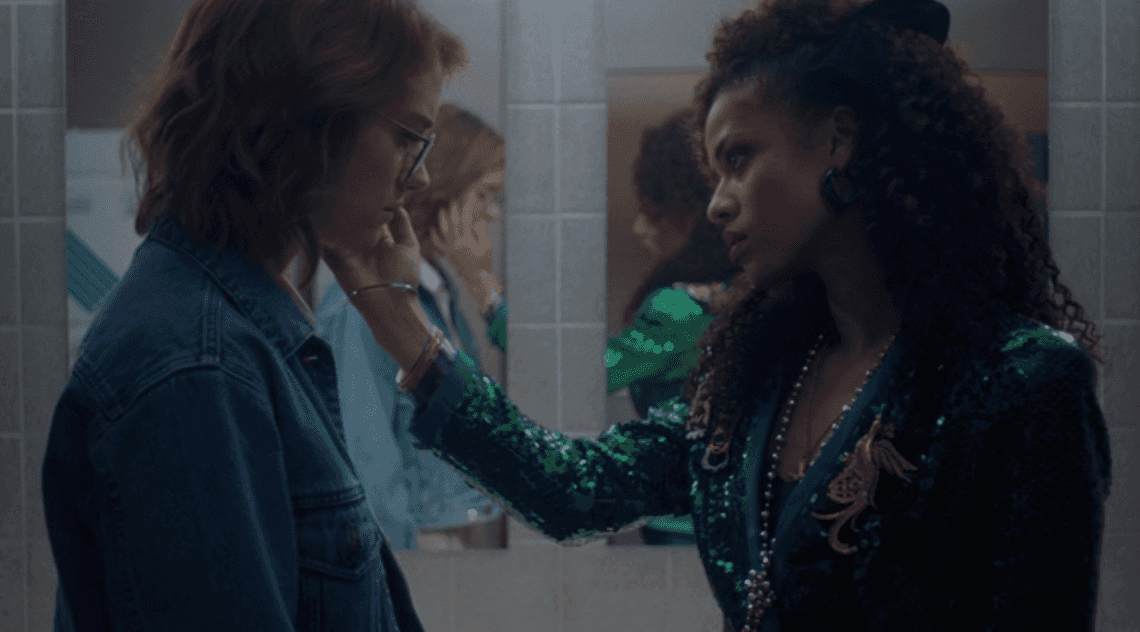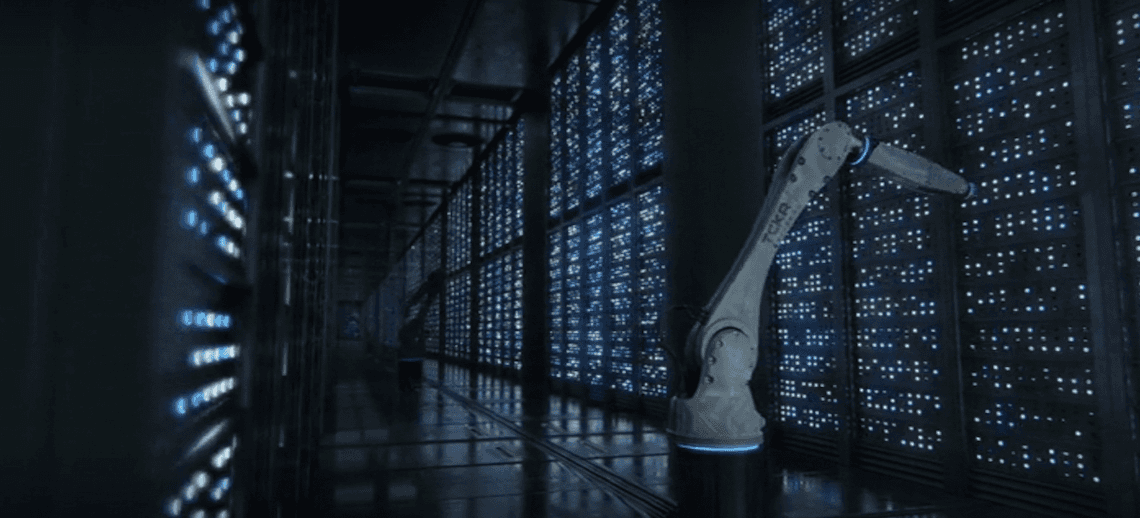Warning: this article contains spoilers.
I recently settled down to watch Charlie Brooker’s new series of techno- nightmare anthology Black Mirror, eagerly anticipating what I hoped to be at least a continuation in quality on from the previous series, and suffice to say it didn’t disappoint. However during episode four, San Junipero, I found myself confronted in a way that I hadn’t predicted, and in what felt like thirty seconds of the episode starting, I was drenched in the contents of my tear ducts. This emotional kicking that had reduced me to a simpering puddle, comes in part from the episodes impeccable craft (new home Netflix has raised the shows budget, giving a greater scope than the previous broadcasters Channel 4, the compelling relationship between Kelly (Gugu Mbatha-Raw) and Yorkie (Mackenzie Davis), and intelligent subversion of science fiction/alternate reality tropes. Yet I couldn’t shake just how powerful these parts had come together, that some other sensibility had landed this sucker punch to my entire nervous system.

The episodes well paced emotional arc is underpinned by the slow burning reveal that the 1980s beach town is in fact a computer simulation that you can upload your consciousness to when you die. Both Kelly and Yorkie, besot with physical and psychological motivation to enter San Junipero, are there to experience this form of ‘nostalgia therapy’ and to test whether they wish to become permanent residents. San Junipero offers its residents an eternal life with zero repercussions along with the ability to opt out of the simulation at any point, yet it comes with the crucial caveat of a diminishing sense of the external physical reality. A postulating of such a simulation would require reconsideration of our relationship to mortality, morality, and corporeality, to name but a few. It’s classic science fiction territory, à la Ghost in the Shell and Do Androids Dream of Electric Sheep, but where San Junipero steps away from rehashed trope is in the use of nostalgia having been processed into a clearly functional, all be it ethically challenging, service. The artificiality and degradation occurring through prolonged exposure to the simulation is off set by the other possibilities such a service could offer. The simulation can equally be a place for personal exploration, even salvation, and not just an artificial neon-dream and despite it no doubt being used less pragmatically by some, it clearly gives some residents the chance to live out an aspect of themselves which in reality they may never have been able to.
Considering this notion of ‘nostalgia therapy’, it appeared worthy to investigate how these ideas relate to our own sense of nostalgia, as it appears to be a cyclical part of modern life, and one which isn’t going away any time soon. In previous decades, before the commercial availability of laptops and smart phones, the cultural residue of the past would mostly be encountered at niche events, in thrift shops, or stored in photo albums tucked away in lofts. Now we’re experiencing personal artifacts as embedded within our digital identities, which are often arbitrarily reintroduced to us through algorithm or habitual click patterns. When the nebulous nature of feeds and networks brings the shared past into your present, the observation of these can feel rupturing, uncanny, oddly soothing and intrusive, as you’re prompted out of the blue to re-connect with a semblance of your past self. It’s a very different and much more abstract notion of encountering the past, one which presents itself as objectively scribed in a time line, yet clearly is still drawn from a hazed, and jumbled immateriality. It’s as ambiguous and emotionally vague as it ever was, but does give pause for thought when our digital histories become ever greater in length. How will these digital spaces affect our construction of the past and how will our relation and interaction alter with that image of self. When we’re presented with these past images what’s revealed is a modified emotional intersect between the digital and physical, one with an altered sense of immersion.

Obviously there’s still a great deal of development needed before a nostalgia simulation like the one in San Junipero is viable, but tracing an outline of how nostalgia can be ‘captured’ and turned into something potentially utilitarian crystallises a contemporary problem. These moments spent diving into the rose hued pool of the past, offer a respite, a break from fragmented screen time and uncertainty fuelled by new media. The desire to locate and stabilise oneself through an imagined point in the past appears to be ever more striking. This reconnection to a constructed past is for the vast majority of the time fairly innocuous, generally playful, all be it still serving the participant in a loose ‘therapeutic’ sense, something which could be opened up to more complex medical and social usage in the future. But in the unexpected encounter of these past elements, does it act in reinforcing the fragmented constellation of reality, and does this lead to a mutation of nostalgia, of how we think about our pasts, screens, and digital identity? One important area of thought results from when there is an inability to draw any kind of distinction between what only may have been and what you wish it could have been, and what happens when it is dissolved and reinforced as an alienating way of thought? It can be seen to lead towards regressive, and distinctly uncritical positions and when combined with the echo chamber effect of social media, this non reflective nostalgia can become a deeply toxic and powerful force. It’s important to recognise that as our digital presence and experience exponentially grows, so our relationship to our past selves will continue to shift, often unexpectedly. It appears the platform for a developed nostalgia therapy may be a distinct possibility in the future.
This is even more viable given the current interfacing between past/present, that we’re already in the midst of a primary form of digital nostalgia therapy, which will only develop in lieu of the advancements seen in VR, brain mapping, augmented reality and expansion of digital worlds such as Second Life. But what San Junipero so effectively shows is that within these evolving considerations, at the core of our existence will still be the same human issues: the struggles, desires, passions and needs. And in this particular instance, the coming together of two lost souls to be at least momentarily, liberated by love. For all their cerebral pondering, the technocratic and philosophical through lines, nostalgic dressings and sci-fi codification, they mostly act as secondary force, explosive in their amplification of the relationship between the two leads, but never the crux of the emotion. Why Kelly and Yorkie were in San Junipero in the first place testifies to the baring of weight a personal sense of duty, complexity of societal structures and quite simply being in the wrong place at the wrong time, can bring upon a persons life. And also how this can be really bloody unfair sometimes. It appears that Brooker and director Owen Harris had a very clear focus for the episode, which gives a lightness of touch throughout, keeping the ills of physical fragility in balance with the perfection of the hypnogogic simulation, but most importantly ensuring a parity between them. Even though the sci-fi had to be executed expertly for the undertones to properly resonate, it’s the human relationship and longing for connection that really drives the episode into something exceptional.
We will always be in conversation to the complexities of nostalgia’s influence, and it’s more important than ever to keep an openness to how this could be utilised to benefit personal grievances, illness and broadening experience. San Junipero offers a hope, of love, of a second chance and of a prosaic way of thinking. So, aside from the likeliness of more soggy outbursts (it’s healthy), who knows what may come from these developments. We indeed may yet find that ‘heaven is a place on earth’.
‘Moving Body Image – Nostalgic tailspin through screens’ is an article written by David Houston. You can follow David on Instagram or check his site on WordPress.

